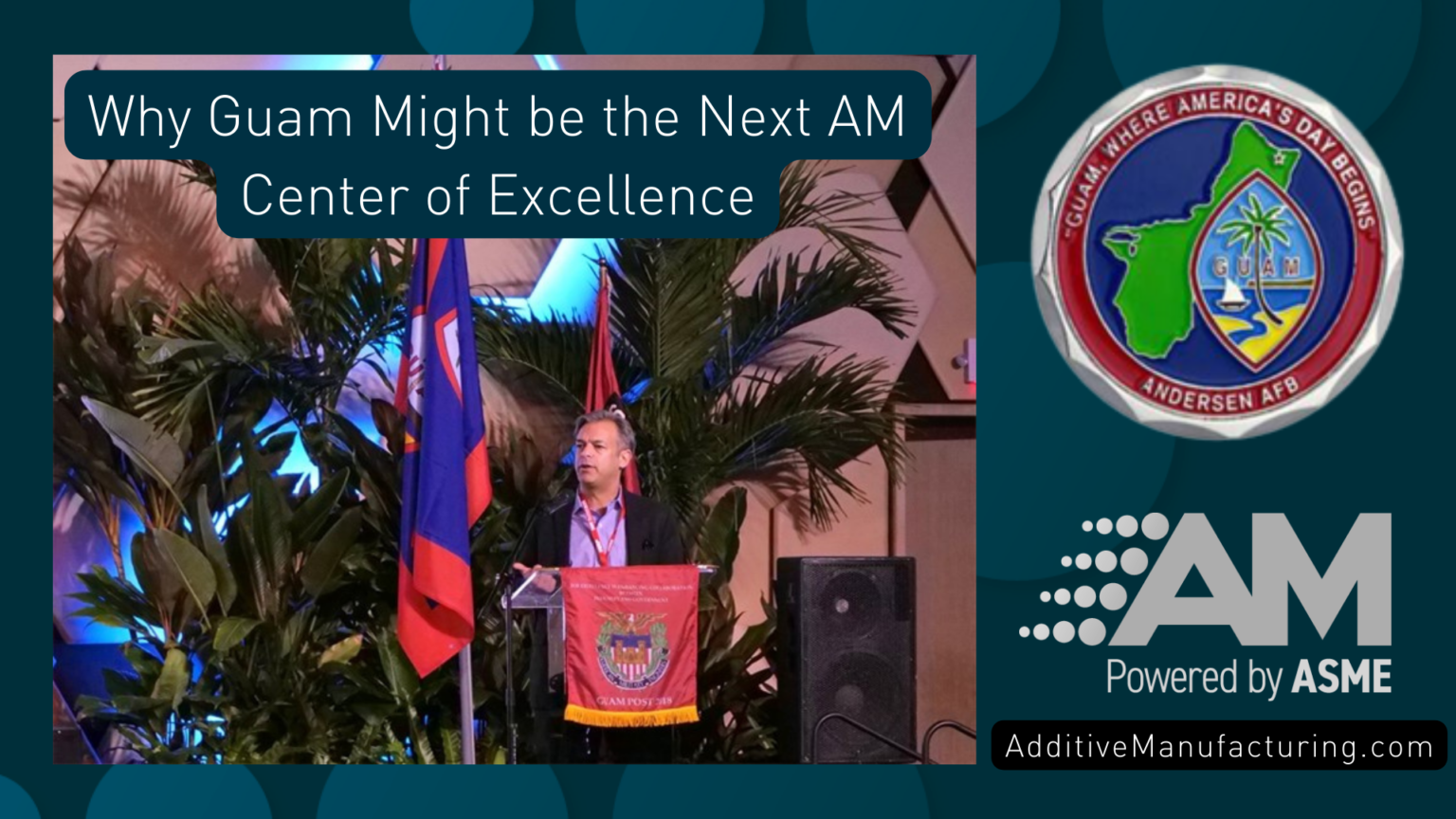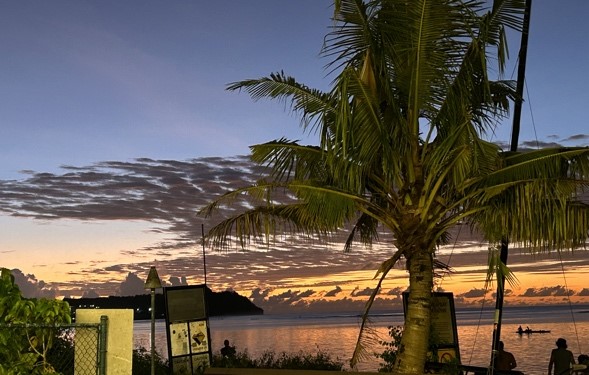
In November 2022 a team from ASTRO America touched down in Guam for a week of meetings. The tropical island territory is referred to as “where America’s day begins” – both because of its time zone and its position as a welcoming tourist destination with high-end hotels and powdery beaches. But this was no vacation; rather, it was an intensive seven day examination into whether industrial additive manufacturing can have a role on Guam.
So why had we traveled 7,000 miles, with travel times of 25-30 hours, to a tiny island in the west Pacific? ASTRO America was commissioned in August 2022 to conduct a feasibility study for bringing industrial AM to Guam to provide more economic diversity, advance U S. national security, and provide new employment opportunities for the people of Guam.
Guam is an island nation just 30 miles long and 8 miles wide with a population of about 154,000. It is a territory of the USA. In military parlance, it is the “tip of the spear”– situated 1,900 miles from the Korean peninsula and 1,700 miles from Taiwan, it remains among the US’ most critical posts in the western Pacific for intelligence, surveillance and reconnaissance assets, fighter aircraft, long range bombers, and our critical submarine fleet. Due to its position on the international dateline, Guam is 14 hours ahead of the mainland US which is why it has the slogan “Where America’s Day begins” on its signs and license plates. In practice this means that on Guam you can watch Sunday Night Football live during breakfast on Monday or, in the case of the Superbowl, my contacts tell me they had the TVs on at the office during the Monday morning work hours.

The island is almost 100% reliant on imports and supply chain fragility remains a high concern, so there is a desire to build more self-reliance into the system. There is also a concern about loss of talent as key workers relocate to the mainland United States or other countries. Reports show that the mean hourly wage on the island is about 32% lower than the nationwide average while housing prices remain high. Manufacturing on the island is minimal, with a few machine, welding and metal bending shops, but otherwise mostly limited to food production. The vibrant construction industry in Guam also has a deep reliance on foreign workforce to try and meet demand.
That is where an AM blueprint can come in—it could change the island’s economic future. At the same time, this type of development could help address any number of local issues on the path to economic recovery, ranging from unemployment, which reached an all-time high in 2020; to homelessness, which has become worse in recent years; and other issues exacerbated by the pandemic crisis. On the ground, the team toured key facilities on the island and spoke with public and private stakeholders to gain additional insights. Another highlight of the trip, ASTRO’s President Neal Orringer presented at the Guam Industry Forum, hosted by the Society of American Military Engineers (SAME), where he explained how 3D printing is revolutionizing manufacturing across the Defense industrial base and the potential it offers to Guam. On November 17, ASTRO hosted a workshop of its own, keynoted by Governor Lou Leo Guerrero, bringing together many key stakeholders on the island to discuss ideas and share thoughts.

The team also scouted for locations for a future AM Center of Excellence. Among them were the University of Guam, Guam Airport Authority, and the Port of Guam. Additionally, they met with individuals and groups regarding Defense requirements, supply chain needs, diversity and inclusion and STEM initiatives.
Industrial 3D printing capabilities could be a game-changer for Guam, overcoming logistical challenges and reducing requisition times for mission-essential parts by 90%. This, as more than $11 billion in new military and commercial construction, maintenance and service contracts are expected in Guam and the Indo-Pacific Region over the next five years.
Starting to ‘Make’ and Thinking about Making
The island is, in my opinion, at least 15 years behind the US mainland for consciously organizing and promoting such things as Makerspaces, STEM education and developing ideas for new, sustainable businesses. But everyone has to start somewhere, and Guam is no exception. For AM it is almost virgin territory.In February 2022, University of Guam opened its first-ever Makerspace, as part of the Guam Green growth (G3) initiative. The Makerspace combines desktop 3D printing, laser cutting, and machining along with systems for research on recycling waste into usable products. It is delivering workshops that are beginning to inspire creative ideas and solutions among the local populace. The center is also planning coding camps and CAD camps. With 4 full-time employees, the center has small beginnings but big ambitions:
“We are here to help local businesses grow,” said Dr. Austin Shelton, Director of the Center for Island Sustainability, University of Guam. “Once they start to flourish we aim to expand our facility a lot, ultimately offering warehouse space and more.”
For recycling projects, the talented G3 team has already developed a way to recycle waste plastic into 3D printing filament, and is researching and testing methods to make melted plastic soda bottles into bricks for non-structural uses such as bus shelters.
In September of 2021, STARBASE Guam was founded. In a single year this premier STEM initiative, funded by the DOD, has successfully exposed hundreds of fifth grade students in Guam to week-long STEM classes, and now is expanding it out to Middle and High Schools. With well-equipped classrooms with multiple Makerbots and On Shape CAD software, STARBASE is also bringing coding through the use of drone kits as well as other STEM activities.
There are also 3 relatively new public charter schools focused on STEM education: The CareerTech High Academy is just over a year old and has 75 students. SIFA Learning Academy serves grades K-8 with current enrollment of 348 students. The iLearn Academy, which was the first STEM school formed on the island, has 740 students and handles grades K-5. The movement to build STEM knowledge into Guam is underway but it also needs a much more concerted, collaborative effort from the Government of Guam on down. Right now the only engineering degrees on offer are in civil engineering and architecture, with skills training in Autodesk Revit and AutoCAD. The lack of mechanical 3D skills training on the island is evident and is only starting up now due to the determination of the team at the G3 Makerspace and the leadership of STARBASE Guam.

If the feasibility study into bringing industrial AM into Guam is positive, then the planning for establishing a ‘center of excellence’ cannot occur in a vacuum and without local participation at all levels. For ongoing sustainable success, this new center would need to not only respond to demand signals for industrial parts, but also be a part of the growing ecosystem for STEM training, entrepreneurship and ecologically-sound production. While any initial implementation might require some expertise to be brought in, probably via University collaboration, success will only be achieved through developing home-grown talent.
Watching the Demand Signals
A key aspect of the Guam feasibility study is the existence, or potential development, of demand for industrial AM. With lengthy supply chains to the island, parts can take months, if not years, to be delivered. Clearly the DOD tenants across the island present opportunities for novel logistical support, especially with on-demand production. Frustrations exist across commercial enterprises for sourcing critical and non-critical parts for planes, automobiles, heavy equipment and more. The healthcare industry in Guam is just now starting to observe AM applications for medicine and dentistry but is years behind the continental US. As importantly, an industrial AM center will need to support new business initiatives on the island, most likely starting with prototyping and then adapting to AM production.
What’s Next?
The results of this feasibility study are not yet published, but if they show as strong potential for public-private partnership, then ASTRO America will move into Phase II for identifying specific demand, planning an AM center and developing funding. The research team will be looking at building a consortium between 3D printing OEMs, DoD, industry, and academia both on- and off-island.
ASTRO America is thrilled to be working on this key project in collaboration with the amazing people of Guam, and looks forward to delivering a comprehensive report.


